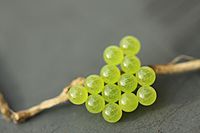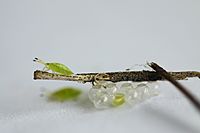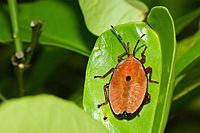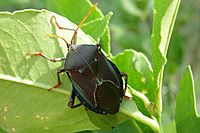Musgraveia sulciventris facts for kids
Quick facts for kids Musgraveia sulciventris |
|
|---|---|
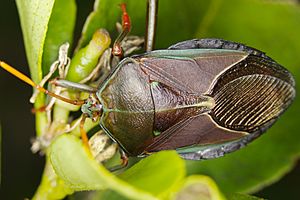 |
|
| Scientific classification | |
| Kingdom: | |
| Phylum: | |
| Class: | |
| Order: | |
| Superfamily: | |
| Family: |
Tessaratomidae
|
| Subfamily: |
Oncomerinae
|
| Genus: |
Musgraveia
|
| Species: |
M. sulciventris
|
| Binomial name | |
| Musgraveia sulciventris Stål, 1863
|
|
| Synonyms | |
|
Oncoscelis sulciventris |
|
The Musgraveia sulciventris is a large insect found in Australia. It's often called the bronze orange bug or just "stink bug." These bugs are known as pests, especially for plants like oranges and lemons. They suck the sap from trees. This can make the flowers and fruit fall off.
Contents
What is the Bronze Orange Bug?
The bronze orange bug is a type of stink bug. Scientists give every living thing a special name. The bronze orange bug's scientific name is Musgraveia sulciventris. A Swedish scientist named Carl Stål first described it in 1863. He called it Oncoscelis sulciventris. Later, in 1957, other scientists changed its name to Musgraveia sulciventris. This bug belongs to a group of insects called Tessaratomidae.
Life Cycle of the Bronze Orange Bug
Bronze orange bugs start to appear in late winter. They mate from late November to early March. After mating, a female bug lays 10 to 14 eggs. She can lay up to four groups of eggs. She usually places them on the underside of a leaf.
The eggs are bright green and round. They are about 2.5 mm (0.1 in) wide. How long it takes for the eggs to hatch depends on the weather. On average, they hatch in about 7.4 days if it's 25 °C (77 °F).
When they first hatch, the bugs are called nymphs. They are light green and hard to see. They go through five stages of growth, called instars.
- The first stage nymphs stay close to their eggs. They are clear, pale green, and have orange eyes.
- The second stage nymphs become more pale yellow.
- As they grow, they change color. Young bugs are often bright orange.
- Adult bugs grow to be about 25 mm (1 in) long. They change from orange to their more common bronze color.
Where Does it Live?
The bronze orange bug lives in Eastern Australia. You can find it in Queensland and New South Wales. Its home range has grown a lot since Europeans first settled in Australia. It can now be found as far south as Wollongong.
Why is it a Pest?
Bronze orange bugs originally lived on native Australian plants. These include the desert lime (Citrus glauca), the Australian finger lime (Citrus australasica), and Correas.
However, they have become a big problem for citrus farms. They suck the fluid from new leaves and young fruits. This makes the plants turn yellow and the fruits fall off. These bugs can cause a lot of damage to entire crops.
How Does it Defend Itself?
The name "stink bug" comes from a smelly liquid these insects spray. They do this when they feel threatened. This liquid comes from special glands in their chest. It is made of chemicals that are harmful to other insects.
The bronze orange bug's spray is also very strong for larger animals, like birds. It can even hurt human skin. If it gets into your eyes, it can cause temporary blindness. The bug can spray this liquid up to 0.6 m (2 ft) away!
Who Eats the Bronze Orange Bug?
Some insects are natural enemies of the bronze orange bug. These include:
- The common assassin bug (Pristhesancus plagipennis)
- The predatory bug Amyotea hamatus
- Tiny parasitoid wasps like Eupelmus poggioni and Telenomus species


